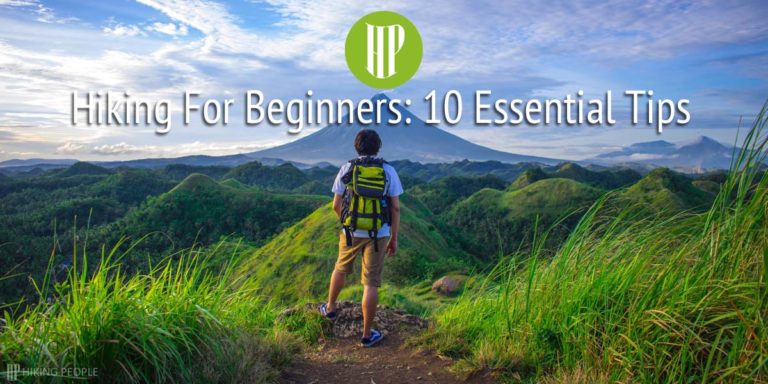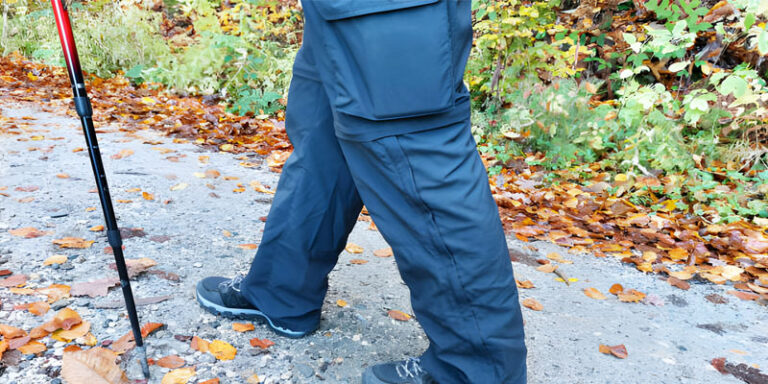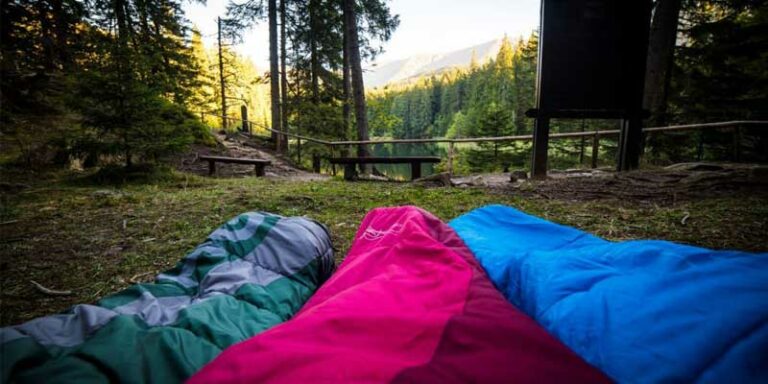Grand Teton National Park in northwest Wyoming expands over an area of approximately 310,000 acres. The park includes major peaks of the 40-mile-long Teton Range as well as most of the northern part of the Jackson Hole valley. This popular destination offers guests a variety of seasonal outdoor activities including mountaineering, hiking, and skiing. But what makes this place so special is the unmatched sightseeing opportunities it offers.
Grand Teton National Park is sometimes overshadowed by its larger neighbor, the Yellowstone National Park. But that is also rightly so. There is so much to do in Yellowstone National Park that people don’t make it down to the Grand Teton National Park. That, however, is a mistake. You might regret not going or giving enough time to this gorgeous park.
So if you are going to visit and if this is your first time, here are the 10 must-see views in Grand Teton National Park.
1. Jenny Lake
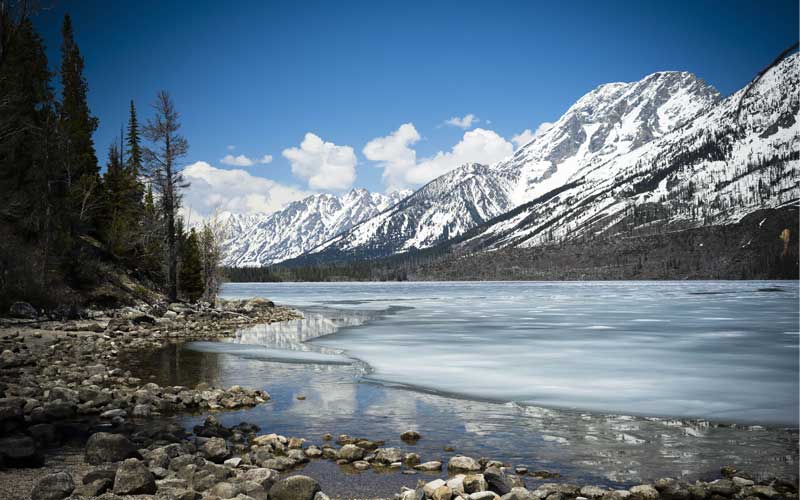
Jenny Lake sits at the base of Cascade Canyon in the Grand Teton National Park. There is a shuttle service available across its waters and the area also has the Jenny Lake Lodge, where cabins and fine dining is offered.
The lakeshore is divided into two zones: North and South Jenny Lake. The South has more facilities and the visitor center, ranger station, campground, and docks are present here. The North features a boat launch, picnic area, and trailhead. The North has a fewer crowd and is relatively quiet.
You can stop by Jenny Lake Visitor Center to get some information about the area which makes it easier for you to decide what to do. The visitor center shows you informational displays and interactive presentations and informs you of the history and the geological significance of the area.
You can take a short walk from the visitor center to the Jenny Lake Ranger Station to pick up your backcountry permits.
Jenny Lake provides opportunities for a lot of activities. You can choose to hike around the lake, choose to rent a kayak or a canoe. You can also choose to cycle around the lake or go for a scenic drive.
2. Snake River Overlook
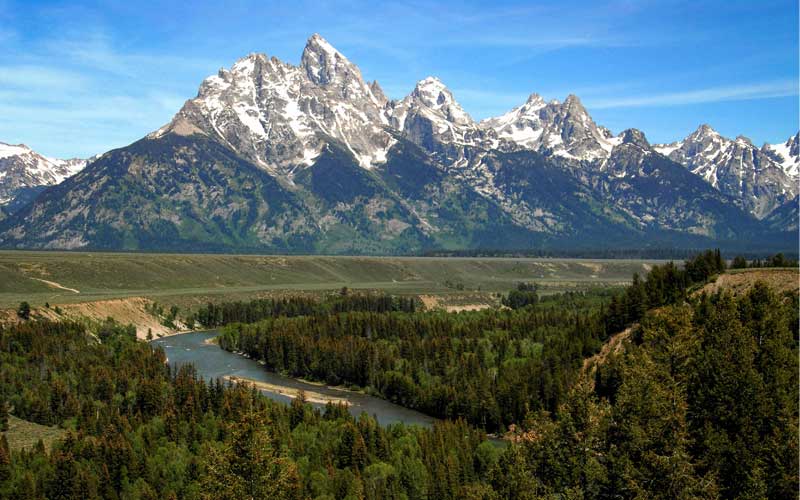
Snake River Overlook was made famous by the photographer Ansel Adams and it is easily accessible from the roadside parking, nine miles of Moose on the main highway. 70 years ago, Ansel photographed the once unobstructed view of the Snake River. The view is now blocked by the growth of trees. But after all this time, it remains to be one of the most iconic views in Grand Teton National Park.
As the name implies, the overlook provides a bird’s eye view of the Snake River. The river is in a distant swirl from the overlook and is dominated by the pine-covered landscape of the Jackson River Valley and the Tetons in the distance. You will notice a subtle westward tilt of the valley as you look at the tree lines on both sides of the valley. The slope is the result of small earthquakes that caused the western part to drop a bit.
With over a million miles of designated wilderness, the possibilities of sightseeing are endless in the Bridger-Teton National Forest. Tour options include a 2-hour backcountry summer ATV excursion, Snake River rafting, winter snowmobile tours, and much more. Visiting the overlook at all times of the day, it is stunning at both sunrise and sunset.
3. Moose-Wilson Road Scenic Drive
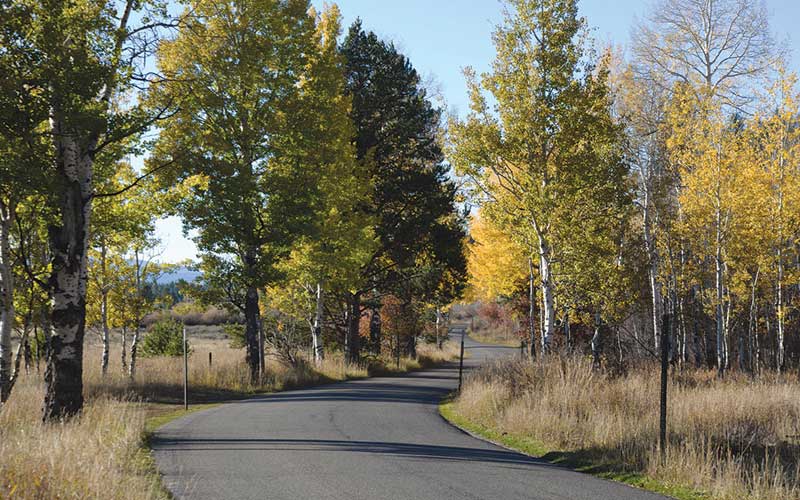
The Moose-Wilson Road is a narrow, windy, 8-mile scenic drive between Teton Village and Moose, WY. This road is close to RVs and trailers. The 1.5-miles of unpaved road will be the bumpiest road you will ever be on. So take it slow to prevent your car from losing parts on this road. You will need a park pass if you are traveling from Teton Village to Moose but not vice versa. A check station at the North of Teton Village is where you can but passes from.
The road passes through the beautiful aspen trees along with pine trees, tall grasses, and a variety of flowers. You may also find some moose, bears, beavers, deer, and foxes. Moose are spotted in all parts of this road. Whenever you see ponds, look to see if there is a moose grazing on water lilies. You will most certainly come across beaver dams and may even see beavers swimming. Your chances of spotting wildlife increase if you go around sunset or sunrise.
This is a slow road along with dirty and bumpy parts. The road is narrow with a lot of blind corners. You will not cover these 8 miles in 8 minutes. You will be frequently tailgated. The tailgaters are seasonal or local employees. Just let them pass. Do not block them or speed up to accommodate them.
4. Jackson Lake Dam

Jackson Lake Dam was built in 1906 in the Grand Teton National Park to provide water to farmers and ranchers in southern Idaho some 800-miles away. The dam is located 30-miles north of the town of Jackson Hole, Wyoming, and lies between Signal Mountain Lodge and the Jackson Lake Junction. The lake was formed due to glacial gouging from the neighboring Teton Range. Now the main source of water is the Snake River flowing from the north.
Many facilities of the Grand Teton National Park are closed from mid-October to mid-May. But the dam never closes. It just becomes difficult to reach depending on the read conditions during the winter. Visitors can park in an area near the dam and then cross the dam to make their way down to the Snake River.
Jackson Lake provides a lot of opportunities for watersports. It is the only lake in the Grand Teton National Park that allows water-skiing, sailboats, windsurfing, and waterboarding in addition to hiking, wildlife viewing, and fishing. After checking out the dam and the lake, you might want to stop at Jackson Lake Lodge for lunch or dinner.
5. T.A. Moulton Barn
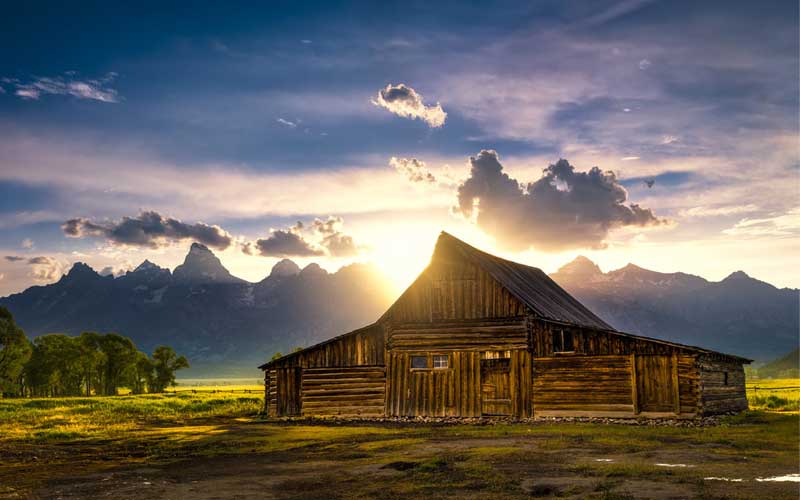
Thomas Alma Moulton first established this property in 1908 as a bachelor. He came over the Teton Pass with his brother and a neighbor from Teton Basin, Idaho. What remains of this property is only a barn. But the barn has become a legacy that the Moultons could have never imagined. This barn is known as the “most photographed barn in America”.
The barn is a part of Mormon Row, which was established in the late 1800s. Mormon settlers came from Idaho and formed small homestead communities. Today, the clusters of historic buildings they built look like a ghost town. It is now protected to preserve the spirit of the American frontier.
The photo-friendly structure has become a symbol of Jackson Hole. Photographers flock to the site to capture the scenic vistas of the historic structure with the Teton Range in the background. Drive north from Jackson on highway 191 past Moose Junction and turn right onto Antelope Flats Road. Follow the road about 1 ½ mile until you see a north-south running dirt road marked by a distinctive pink stucco house on the left with a small dirt parking area. A trail brochure and interpretive sign can be found in the parking lot.
6. Craig Thomas Discovery & Visitor Center

Craig Thomas Discovery & Visitor Center was opened in 2007 to replace the old facility. It was built with the help of federal grants and private donations and is adjacent to the park headquarters in Moose, Wyoming. The 22,000-square-foot facility orients, educate, and inspires visitors to make discoveries of their own in the park.
In addition to the exhibit area, visitors can wander through a 900-square-foot gallery room with displays of fine art from the park’s permanent collection and other traveling exhibits. You will also find maps, books, and other educational materials to purchase from the Grand Teton Association bookstore. All profits of the bookstores support educational and research programs in the park.
7. Menor’s Ferry Historic District
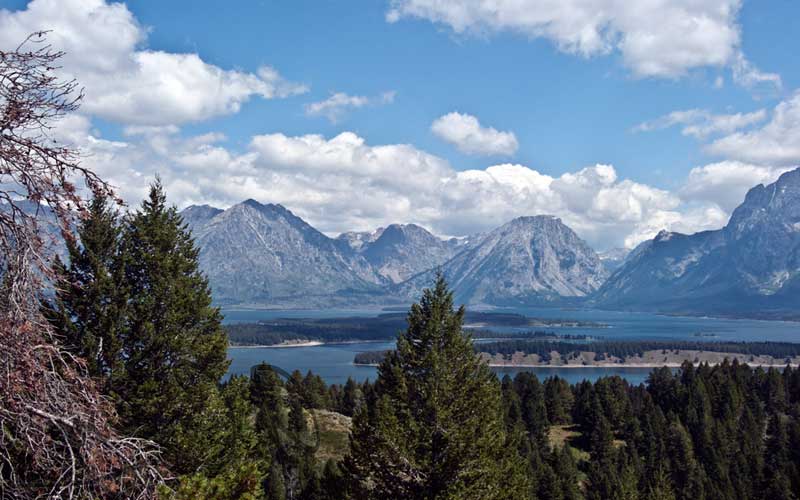
At roughly two-tenths of a mile north of the Moose Entrance on Teton Park Road, Menor’s Ferry Historic District is situated. Willian D. Menor came to Jackson Hole and set up his homestead beside the Snake River in 1894. He constructed a ferry that became an important crossing point for the early settlers in the Jackson Hole valley. Along with that, he also constructed his cabin and a general store.
Visitors can get the opportunity to see to visit the Menor’s cabin, general store, ferry, and transportation shed that has a collection of wagons and coaches from the homestead era. You will also find Maud Nobel’s cabin, which played a major role in the establishment of the Grand Teton National Park.
A short distance from the trailhead and you will come across the first building on the tour built by Bill Menor: his cabin and general store. The west wing was built by Menor in 1849 and then the central wing in the following years. The east wing was added in 1905 which became the general store. Visitors can see the furniture inside or even buy goods from the store even now.
8. Oxbow Bend
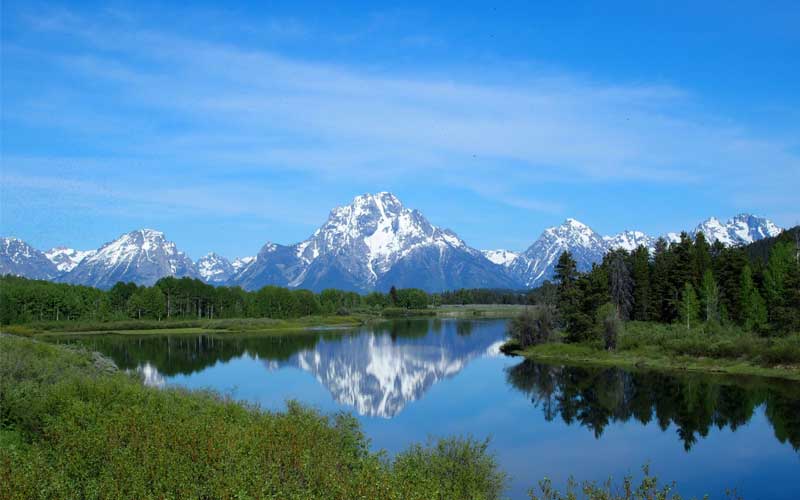
Oxbow Bend is the most photographed place in the entire Grand Teton National Park. What makes it so attractive for photographers is the reflection of Mount Moran in the Snake River. It is an iconic image and is also the most recognized image of the Grand Teton National Park in the whole world.
Oxbow Bend is located just a little over a mile straight east of the Jackson Lake Junction on Highway 89. The sight is something that can’t be missed so easily. It is where the Snake River becomes very wide and Mount Moran can be seen reflecting on the still water of the river. It is truly a breathtaking sight.
Oxbow Bend is also one of the best places to see moose, otters, black bears, and other animals including grizzly bears. In the last few years, more and more grizzly bears have been reported in Oxbow Bend. If you are lucky enough, you might also see a moose crossing the widest part of the Snake River. You will also come across otters. You never know what you will find in the Oxbow Bend.
9. Grand Teton
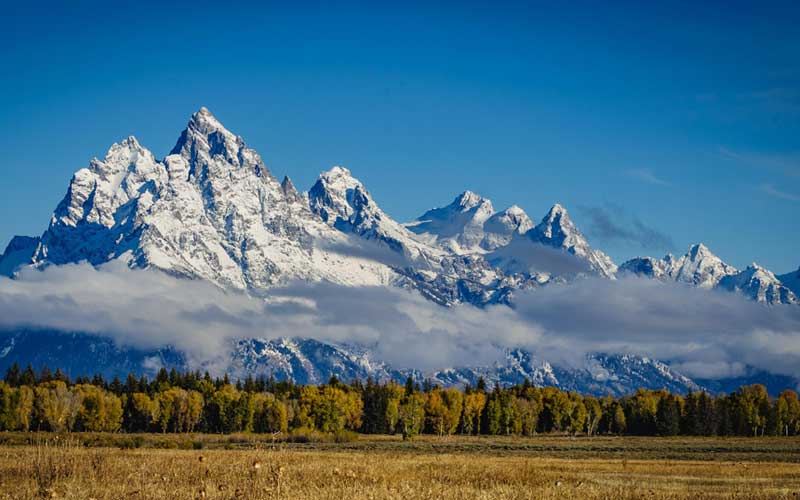
The Teton Range in the Grand Teton National Park is a mountain range of the Rocky Mountains and extends approximately 40-miles in a north-south direction through Wyoming from the southern boundary of Yellowstone National Park to Teton Pass, just west of Jackson.
The height of many peaks is more than 12,000-feet. Grand Teton at 13,770-feet is the highest point and with an elevation of more than 7,000-feet above Jackson Hole. The range is the source of Teton Creek, which is one of the main source streams of the Teton River flowing on the western slope of the range.
When the 19th-century French fur trappers saw the trio of jagged peaks that was high in the sky above Jackson Hole, they described them as “Les Trois Tetons” which translates to “the three breasts”, the tallest of which they called the “Grand Teton”.
There are over 35 routes with 50 variations with more discovered every year. Standing at the summit of the Grand Teton on a clear day will provide you with the most amazing view of the Grand Teton National Park, the joy of which you cannot find anywhere else in the park.
10. Hit the Trail
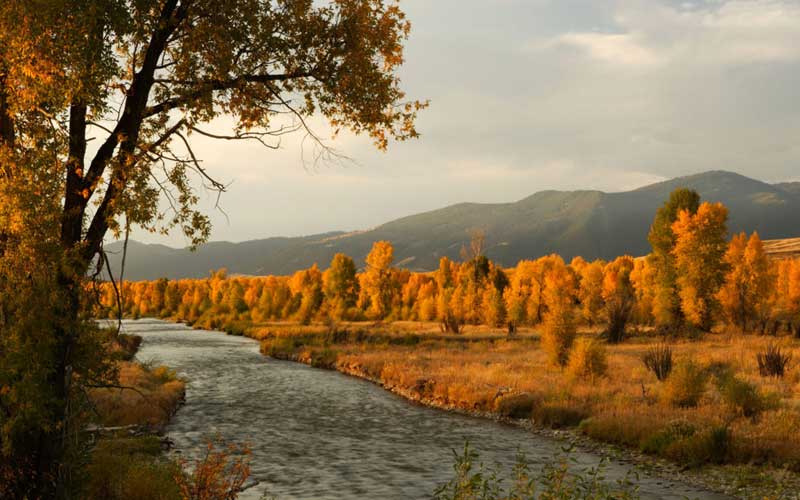
Now, the maps are going to tell you something. They will show you the roads and viewpoints in the Grand Teton. But, there are so many undiscovered areas in the park where you can go that aren’t a part of the map. The open land of the Grand Teton has much more to show you than this.
The Grand Teton provides several hiking opportunities, wildlife observation, and photography. So don’t be shy to hit the trials. You will never know what you will find. There are several tracks that you can walk through that take you to other breathtaking places in the Grand Teton National Park.
You can get to other glacial lakes which can provide you with a place to relax and even have a picnic if you are with the family. Then there are several canyons to explore in the Grand Teton. Inspiration Point is one of the most popular hiking destinations in the Grand Teton National Park that offers outstanding views of Jenny Lake, Jackson Hole, and Gros Ventre Mountain Range.

